![]()
![]()
![]()
Use LEFT and RIGHT arrow keys to navigate between flashcards;
Use UP and DOWN arrow keys to flip the card;
H to show hint;
A reads text to speech;
84 Cards in this Set
- Front
- Back
- 3rd side (hint)
|
Culture |
Culture is the ways of life that are common to a society. The totality of socially transmitted behavior patterns, arts, beliefs, institutions, and all other products of human work and thought. |
|
|
|
Components of culture |
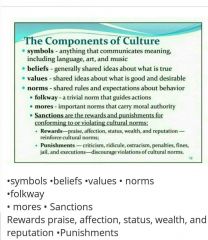
|
|
|
|
Traditional Societies |
Traditional societies are similar societies with similar lifestyles. Therefore, their cultural changes are slower. |
|
|
|
Modern Societies |
Modern societies are societies where different population groups live and individuals have different occupational groups. For this reason, changes are more rapid and more susceptible to external influences and changes. (Multicultural) |
|
|
|
Interculturalism |
Interculturalism refers to support for cross-cultural dialogue and challenging self-segregation tendencies within cultures The philosophy of exchanges between cultural groups within a society. |
|
|
|
Intercultural communication focuses on |
1-Development of information technologies 2) economic globalization, 3) increase in multiculturalism and / or cultural diversity, 4) population growth |
|
|
|
Perceptions/Values that Differentiate Cultures |
•Individualism and collectivism •High-context versus low-context cultures •Perception of space •Perception of time |
|
|
|
Individualism versus collectivism: |
Individualism:Some cultures value individual independence; the individual seeks his own identity, makes decisions based upon his own beliefs.
Collectivism: In other cultures, identity is conferred by one’s group; his family provide the individual with security, protection, and values, and often make important life-defining decisions for him. Individualism focuses on individual freedom; collectivism on group stability and consensus. |
|
|
|
High-context versus low-context cultures |
High Context Culture:Cultures that rely heavily on non-verbal and subtle situational cues in communication. Low Context Culture:Cultures that rely heavily on words to convey meaning in communication. |
|
|
|
Perception of space |
People from different cultures vary in how much space they perceive is needed between themselves and others. For example, individuals from Middle Eastern and Mediterranean cultures tend to be comfortable with less personal space than is generally desired by North Americans and northern Europeans. Some people feel like their personal space is “invaded.” The way in which organizations designate space (who sits where and how much room they are given) also reveals a great deal about status and values in an organizational culture. |
|
|
|
Perception of time ?!!! |
There are also distinct differences between the way in which cultures observe and value time. Some cultures are time-oriented to a high degree (as evidenced by their numerous phrases about “saving time,” “buying time,” “investing time,” and “wasting time”), while others are less preoccupied with “merely time.” There are also cultural differences in time-orientation, that is, in attitudes about the past versus the future. Some cultures revere the traditions and customs of the past, and look for past precedent to justify innovation and change. Other cultures are less concerned with past precedent, and use projected future benefits to justify innovation and change. |
|
|
|
Importance of hierarchies |
Some cultures particularly value formal roles and structured hierarchies, and place great importance on the respect and deference that must be paid to one in a higher position. Other cultures put greater emphasis upon open, informal relationships. All cultures and organizations have hierarchies of some kind; differences are demonstrated by what hierarchies are based on, and how important and constraining they are. |
|
|
|
Other issues or concerns that might be useful in thinking about cultural diversity include: |
• The nature of change (is it viewed as positive or negative?) • Importance and rigidity of gender roles • Criteria/definitions of success • The nature of authority • The nature of humor (what is humorous?) |
|
|
|
The aim of intercultural communication studies |
The primary aim of intercultural communication studies is to eliminate the various prejudices that exist between different national cultures or subcultures within the same culture and between the different ethnic identities and the dominant culture, and to provide intercultural competence to individuals. |
|
|
|
Common problems which are emphasized and tried to be analyzed in intercultural communication studies are |
•Ethnocentrism( Ethnocentrism is a belief that one’s own culture or group is superior to all other groups or cultures.) •Stereotyping(Placing people in certain patterns) •Prejudice •Discrimination •Negativities and misunderstandings caused by differences such as gender, age, race and religion •The lack of tolerance of people with cultural values •The culture which is closed to the outside, skeptical and solid against the outside world •Egoism-megalomania and lack of respect to other cultures •Absence of cultural empathy |
|
|
|
Globalization |
the increasing tendency toward international connections in the media, business, and culture |
|
|
|
Intercultural communication |
the interaction between people from different cultural backgrounds |
|
|
|
Monochronic |
- an orientation to time that assumes it is linear and is a commodity that can be lost or gained |
|
|
|
Personal space (domination space) |
- the immediate area around a person, invasion of which may provoke discomfort or offense |
|
|
|
Polychronic |
an orientation to time that sees it as circular and more holistic |
|
|
|
Acculturation |
The modification of the culture of a group or individual as a result of contact with a different culture. Acculturation is the process of social, psychological, and cultural change that stems from blending between cultures. |
|
|
|
Dimensionality |
Refers to the relations between cultural adoption and maintenance. |
|
|
|
Cultural differences |

|
|
|
|
Acculturation conditions |
Refer to the resources behind the acculturation process. Antecedent conditions can include factors such as perceived discrimination, personality, situational context. |
|
|
|
Acculturation orientations |
Refer to acculturation strategies, styles. Mediators in the acculturation process such as cultural maintenance vs. cultural adoption, or integration, marginalization, separation and assimilation. |
|
|
|
Acculturation outcomes |
Refer to consequences of the acculturation process which can be psychological (internal adjustment, well-being) and behavioral (external adjustment, doing well). From our perspective, acculturative stress is presumed to be part of psychological adjustment and is believed to be affected by acculturation conditions and orientations (unlike other disciplines which may evaluate it as input to other resources) |
|
|
|
Acculturation attitudes |
Refers to acculturation preferences.They are believed to be mostly related to acculturation orientations. |
|
|
|
Acculturation behaviors |
Refers to actual acts. They are assumed to be mostly related to acculturation outcomes. |
|
|
|
Domain-specificity |
Refers to private (marriage, family) vs. public (school, work) life domains. It is argued that acculturation orientations are domain-specific; they may vary among private and public domain. |
|
|
|
Dimensionality |
Refers to unidimensional (individual either maintenance the ethnic culture or adopt the dominant culture) and/or bidimensional (individual may both maintain the ethnic culture and adopt the dominant culture depending on the context) conceptual models. |
|
|
|
Assimilation |
Cultural assimilation is the process in which a minority group or culture comes to resemble those of a dominant group. |
|
|
|
What is the difference between Acculturation and Assimilation? |
• Meeting of cultures always produces results in terms of changes in both the cultures, and acculturation and assimilation refer to two important and different changes in these cultures. • Assimilation refers to the process where some of the majority community’s cultural aspects are absorbed in such a manner that the home cultural aspects get mitigated or lost. • Acculturation is a process where the cultural aspects of the majority community are adapted without losing the traditions and customs of the minority community. • Minority culture changes in the case of assimilation whereas it remains intact in the case of acculturation. |
|
|
|
Models of acculturation |
Berry (2001) states that anthropologists and sociologists have discussed intercultural interaction under two main headings.
1-The first of these topics is about the degree of the relationship between the groups or the fusion of groups with each other According to this approach, the two communities can be fused at different levels. 2-The second topic is about the declaration of the continuation of each group's own culture.The second heading points to the fact that each community may want to maintain its cultural existence independently of the other. |
|
|
|
Culture shock |
A condition of confusion and anxiety affecting a person suddenly exposed to an alien culture or milieu. |
|
|
|
Enculturation |
the process by which an individual adopts the behaviour patterns of the culture in which he or she is immersed . ("Enculturation" is the process of learning your own group's culture. ) |
|
|
|
Acculturation versus enculturation |
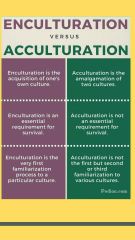
is the difference between Enculturation and Acculturation? • Both enculturation and acculturation are processes of socialization taking place in a society. • Whereas enculturation is a process that helps an individual to imbibe social values, norms, customs etc. of the culture he lives in, acculturation is a two way change process that takes placed when there is a meeting of two cultures. • In acculturation there are changes felt in both cultures though mostly it is the minority culture that gets changed by way of changed language, clothing, customs and practices. • Enculturation helps an individual to survive and better fit into the culture he finds himself surrounded. • No difference between the two terms is accepted in some countries where acculturation is considered as same as enculturation. |
|
|
|
Acculturation |
"Acculturation" is the process of taking on ANOTHER group's culture. |
|
|
|
Bigenderality |
an activity system that is the reflection of biological differences between people in the social life. |
|
|
|
Proxemics |

The distance between two or more individuals. |
|
|
|
Relationship with time |

|
|
|
|
Intercultural Communication Theories |
Theories that have been developed to explain how communication occurs when individuals from different cultures meet.
•Information Systems Theory by Edward T. Hall. •Theory of Cultural Dimensions by Geert Hofstede |
|
|
|
Information Systems Theory by Edward T. Hall. |
Aims to explain the nonverbal components of culture and to reveal its effects on communication. Hall argues that human activities, called ”primary message systems", are common for all people from all countries . |
|
|
|
Primary Message System activities |
These activities are classified as • interaction, •social life •earning a livelihood, • Binary gender •using space, •using time, • learning, •playing, •defense and benefiting from material |
|
|
|
Learning |
•Learning can be defined as acquiring the information necessary for adaptation to the environment. • The way and the form of learning varies from culture to culture. Members of some cultures learn more easily based on memory, others on logic. |
|
|
|
Playing |
•The concept of gaming friendship plays a big role in human relations from childhood. •Games allow you to socialize and get friends. |
|
|
|
Defense |
Man has elaborated his defensive techniques in •warfare • religion, •medicine • law enforcement. |
|
|
|
Exploitation (use of material) |
•In order to exploit the environment all organisms adapt their bodies to meet specialized environmental conditions. E.g.: the long neck of the giraffe (adapted to high foliage of trees) •When man appeared with his specialized body, such extension activities came into their own. Some examples •weapons •atom bomb •Clothes •houses •furniture •power tools •telephones •Money • transportation networks !(All man-made material things can be treated as extensions of what man once did with his body or some specialized part of his body) ! |
|
|
|
Theory of Cultural Dimensions by Geert Hofstede |
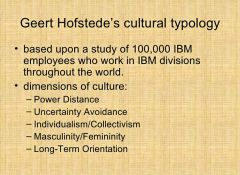
Includes three broad dimensions •Expected social behaviors •Man's search for truth •Importance of time |
|
|
|
Power distance (PDI) |

|

|
|
|
Small PDI vs Large PDI |
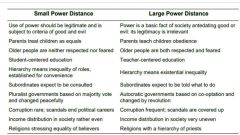
|
|
|
|
Individualism vs Collectivism |
Is the extent to which to self or the group constitues the center point of identification for the individual. Individual self interest is pursued individually or as a part of a group. Artifacts of I /C •Firm as family •Utilitarian decision making •Group performance |
|
|
|
What are individualism and collectivism |

|
|
|
|
Ten Differences Between Collectivist and Individualist Societies |
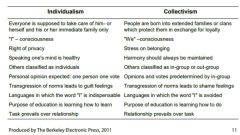
|
|
|
|
Masculinity vs Feminity |
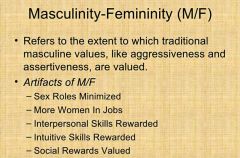
|
|
|
|
What are masculinity and femininity |
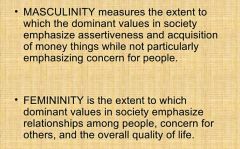
|
|
|
|
Ten Differences Between Feminine and Masculine Societies |
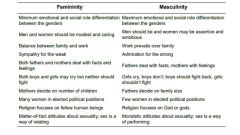
|
|
|
|
High and Low Masculinity |

|
|
|
|
Uncertainty Avoidance Index (UAI) |
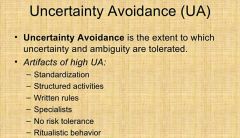
|
|
|
|
Ten Differences Between Weak- and Strong- Uncertainty Avoidance Societies |
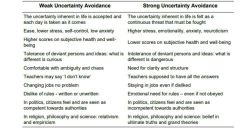
|
|
|
|
High and low UAI |

|
|
|
|
Long- Versus Short-Term Orientation |
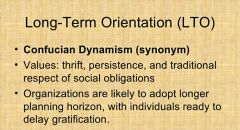
|
|
|
|
Ten Differences Between Short- and Long-Term-Oriented Societies |
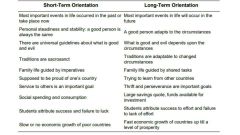
|
|
|
|
Indulgent |
Indulgent societies allow relatively free gratification of basic and natural human desires leading to enjoying life and having fun. |
|
|
|
Restrained |
Restrained societies suppress gratification of needs and regulate it by means of strict social norms |
|
|
|
Indulgent societies |
•People feel healthier and happier •A perception of personal life control •Leisure ethicOptimism, positive attitude •More extraverted personalities •Having friends very important •Active participation in sports •Less moral discipline •Looser sexual mores |
|
|
|
Restrained societies |
•People feel less happy and less healthy •What happens to me is not my doing •Work ethic •Pessimism, cynicism •More introverted personalities •Having friends less important •Less sports participation •Stricter moral discipline •Stricter sexual mores |
|
|
|
Kluckhohn and Strodtbeck's Values Orientation Theory |
Kluckhohn and Strodtbeck proposed a theory of culture based on value orientation.They suggested that any given society are distrubuted in a way that creates a dominant value system. |
|
|
|
What is human nature? |
•good - emphasize rehab of wrongdoers •mixed - have rehab centers, but also prisons •evil - humans are innately evil, emphasize punishment |
|
|
|
What is the relationship between humans and nature? |
•humans dominate - often modify and control nature for own needs •nature dominates - humans are accepting of what nature brings •harmony between the two - nature plays role in spiritual/religious life of community |
|
|
|
What is the preferred form of activity? |
•doing - emphasizes being productive; very active, always on the go •being - more "stop and smell the roses", enjoy life •growing - emphasizes spiritual aspect of life; somewhat harmony between doing and being |
|
|
|
Time orientation |
•future - saving money, keep planner •present - living in the here and now, realizing potential of the present moment •past - cultures with longer history, emphasis on past and belief that history has something to contribute to the present |
|
|
|
What is the relationship among humans? |
•individualistic - there is more emphasis on the individual than family/group •group-oriented - place more emphasis on the group than individual, including extended family and other groups •collateral - you have connections to ancestors even after their death |
|
|
|
Cultural identity |
It is the identity or feeling of belonging to a group.Cultural identity is the constantly shifting understanding of one’s identity in relation to others.
It consists of •values, •meanings, •customs •beliefs used to relate to the world. |
|
|
|
Core Elements of Cultural Identity |
•Self-Categorization •Cultural Narrative •Identity Centrality •Identity Salience •Cultural Roles and Role Enactments •Cultural Regard |
|
|
|
Self-categorization |
Involves one’s own perceived membership within a cultural group. |
|
|
|
Cultural narratives |
Stories that help a community structure and assign meaning to its history and existence. Cultural narratives include creation stories, which tell a story about the community's origins, and fables, which help teach moral values and ethical behavior. |
|
|
|
Identity Centrality |
Centrality is the degree of importance one’s cultural group membership has to one’s self concept, overall, as well as its importance to one’s self-concept relative to other internalized social group identities. |
|
|
|
Identity Salience |
Salience is the degree of importance one’s cultural group membership has within the context of a given situation. |
|
|
|
Cultural Roles and Role Enactments |
Roles are the sets of behavioral expectations prescribed by a given cultural group. The degrees to which individuals enact prescriptive cultural role behaviors are called role enactments. |
|
|
|
Cultural Regard |
Regard is the degree of positive-negative affect one feels toward his or her cultural group and the degree of positive-negative affect felt about being a member of a particular culture (private regard), and the positive-negative affect one perceives outgroup members experience toward one’s own cultural group (public regard) |
|
|
|
Orientalism |
It is a way of seeing that imagines, emphasizes, exaggerates and distorts differences of East (Islamic) cultures and as compared to that of Europe and the U.S. (West) It often involves seeing Arab culture as exotic, backward, uncivilized, and at times dangerous. |
|
|
|
self-orientalism |
Means self-orienting. Adapting other cultures' way of living instead of your own. |
|
|
|
Two approaches situate self-Orientalism |
Historical approach: Western Orientalist knowledge has been internalized and self-inscribed by the East. Second approach: considers self-Orientalism a profound consequence of the Orient’s striving for modernity. |
|
|
|
Otherness |
Is the result of a discursive process by which a dominant in-group with a difference presented as a negation of identity and thus a motive for potential discrimination . |
|

